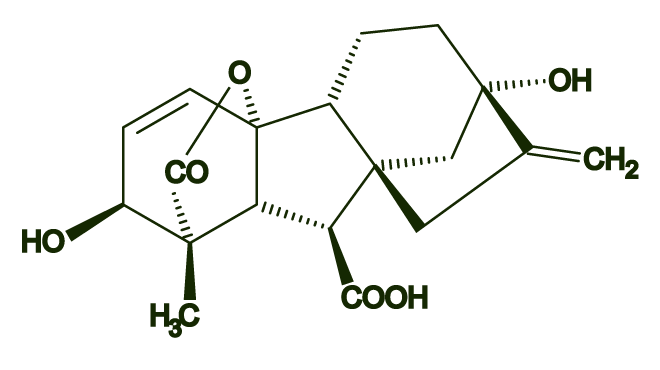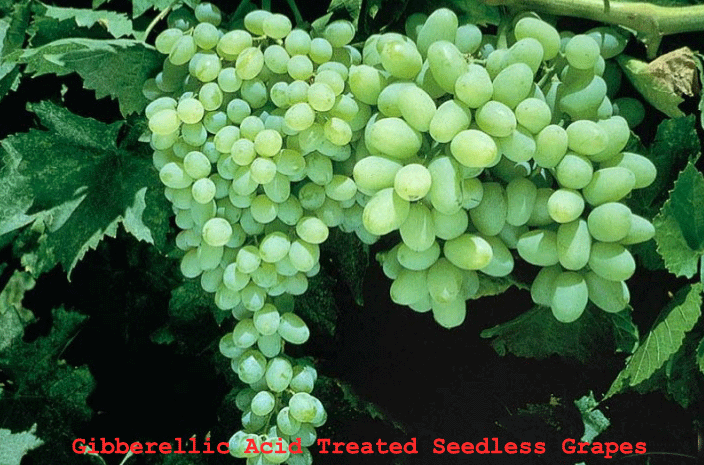- 6-Benzylaminopurine(6-BA)
- Gibberellic Acid (GA3)
- 4-Indol-3-yibutyric Acid (IBA)
- Indol-3-yiacetic Acid (IAA)
- Forchlorfenuron (CPPU)
- 1-Naphthylacetic Acid (NNA)
- 2-(1-naphthyl)acetamide (NAD)
- Chlormequat chloride (CCC)
- Prohexadione-Calcium
- Thidiazuron (TDZ)
- Paclobutrazol
- Abscisic Acid (ABA)
- Brassinosteroid
Gibberellic Acid (GA3)

other name: (1a,2b,4aa,4bb,10b)-2,4a,7-trihydroxy-1-methyl-8-methylenegibb-3-ene-1,10-dicarboxylic acid 1,4a-lactone; gibberellin A3; GA3 (ambiguous)
CAS No. [ 77-06-5 ]
Molecular Formula C19H22O6
Gibberellins commonly known as gibberellic acids Gibberellic acid (GA1, GA2, GA3, ... GA20), a plant hormone stimulating plant growth and development, is a tetracyclic di-terpenoid compound. Gibberellic acids stimulate seed germination, trigger transitions from meristem to shoot growth, juvenile to adult leaf stage, vegetative to flowering, determines sex expression and grain development along with an interaction of different environmental factors viz., light, temperature and water. The major site of bioactive Gibberellic acid is stamens that influence male flower production and pedicel growth. However, this opens up the question of how female flowers regulate growth and development, since regulatory mechanisms/orGibberellic acids other than those in male flowers are mandatory. Although Gibberellic acids are thought to act occasionally like paracrine signals do, it is still a mystery to understand the Gibberellic acid biosynthesis and its movement. It has not yet confirmed the appropriate site of bioactive Gibberellic acid in plants or which tissues targeted by bioactive Gibberellic acids to initiate their action. Presently, it is a great challenge for scientific community to understand the appropriate mechanism of Gibberellic acid movement in plant’s growth, floral development, sex expression, grain development and seed germination. The appropriate elucidation of Gibberellic acid transport mechanism is essential for the survival of plant species and successful crop production.
than those in male flowers are mandatory. Although Gibberellic acids are thought to act occasionally like paracrine signals do, it is still a mystery to understand the Gibberellic acid biosynthesis and its movement. It has not yet confirmed the appropriate site of bioactive Gibberellic acid in plants or which tissues targeted by bioactive Gibberellic acids to initiate their action. Presently, it is a great challenge for scientific community to understand the appropriate mechanism of Gibberellic acid movement in plant’s growth, floral development, sex expression, grain development and seed germination. The appropriate elucidation of Gibberellic acid transport mechanism is essential for the survival of plant species and successful crop production.
GA3 is the principal component in Gibberella culture and it is the most frequently produced GA in commercial industrial scale fermentations of Gibberella for agronomic, horticultural and other scientific uses. China updated its standard GB15955-2011
APPLICATIONS
Mode of action Acts as a plant growth regulator on account of its physiological and morphological effects in extremely low concentrations. Translocated. Generally affects only the plant parts above the soil surface. Uses Has a variety of applications, e.g. to improve fruit setting of clementines and pears (especially William pears); to loosen and elongate clusters and increase berry size in grapes; to control fruit maturity by delaying development of the yellow colour in lemons; to reduce rind stain and retard rind ageing in navel oranges; to counteract the effects of cherry yellows virus diseases in sour cherries; to produce uniform seedling growth in rice; to promote elongation of winter celery crop; to induce uniform bolting and increase seed production in lettuce for seed; to break dormancy and stimulate sprouting in seed potatoes; to extend the picking season by hastening maturity in artichokes; to increase the yield in forced rhubarb; to increase the malting quality of barley; to produce brighter-coloured, firmer fruit, and to increase the size of sweet cherries; to increase yields and aid harvesting of hops; to reduce internal browning and increase yields of Italian prunes; to increase fruit set and yields of tangelos and tangerines; to improve fruit setting in blueberries; to advance flowering and increase the yield of strawberries; and also a varie
Our Technical Material (TC) have the specification as below:
| Items | Specification |
|---|---|
| Appearance | white crystalline powder |
| Content (by HPLC) | 90% min. |
| Loss on Drying | 0.5% max. |
| Specific Optical Rotation [ α ]20 D | +80 |
GHS complaint Safety Data Sheet (SDS) for commercial product of GA3 is available uopn requested.
